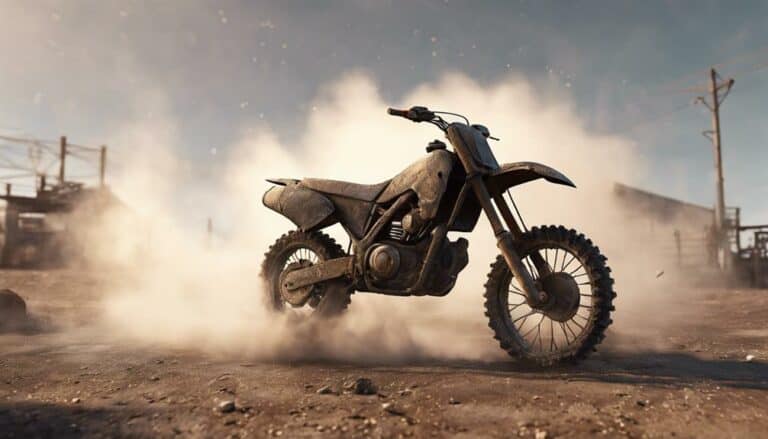If your dirt bike suddenly overheats, shows coolant leaks, or has a shaky temperature gauge, it's time for a radiator check. Address these signs promptly to avoid engine issues.
Key Takeaways
- Sudden spikes in engine temperature signal radiator check.
- Coolant leaks or puddles around the bike indicate cooling system issues.
- Fluctuating temperature gauge readings point to potential radiator problems.
- Inconsistent coolant levels suggest cooling system issues needing attention.
- Abnormal engine temperature spikes require immediate inspection for radiator issues.
Unexplained Overheating Episodes
If your dirt bike experiences sudden spikes in engine temperature, it's an important indication that a radiator check is necessary. Unexplained overheating episodes could stem from various issues within the cooling system. Fluctuating temperature gauge readings might suggest a faulty thermostat or a clogged radiator. When these symptoms occur, it's vital to address them promptly to prevent further damage to your engine.
A faulty thermostat can get stuck closed, leading to overheating as the coolant circulation is restricted. On the other hand, a clogged radiator can impede the coolant flow, causing inefficient heat dissipation. Both scenarios can result in unexplained overheating episodes. Additionally, coolant loss can exacerbate the situation, as the cooling system is unable to regulate the engine temperature effectively.
Coolant Leaks or Puddles Found
Coolant leaks or puddles found around your dirt bike are clear indicators of potential cooling system issues that demand immediate attention. When inspecting your bike, be on the lookout for wet spots near the radiator or hoses, as they often signify coolant leaks. Puddles forming under the bike are a critical warning for a cooling system problem that needs fixing.
These leaks can result from damaged hoses, a cracked radiator, or a faulty gasket. Addressing coolant leaks promptly is essential to prevent further damage to the engine. Regularly checking for coolant leaks is a proactive measure to guarantee the proper functioning of the cooling system and to maintain peak engine temperature.
If you notice any signs of coolant leaks or find puddles forming beneath your dirt bike, it's advisable to investigate and address the issue promptly to avoid potential overheating and engine damage.
Fluctuating Temperature Gauge Readings
When observing fluctuating temperature gauge readings on your dirt bike, attention to potential cooling system issues becomes essential. A stable temperature reading is vital for the proper functioning of the cooling system. Fluctuations in the temperature gauge can point to underlying problems such as a faulty thermostat, a clogged radiator, or a failing water pump. These fluctuations can lead to inefficient cooling and potential overheating of the engine. It's important to address these issues promptly to prevent any long-term damage to your dirt bike.
Regular inspections by a technician can help identify and resolve any cooling system issues before they escalate. If you notice inconsistent temperature gauge readings, it's advisable to schedule a radiator check to make sure that all components are functioning correctly. By addressing these fluctuations early on, you can maintain the best performance of your dirt bike and prevent any potential breakdowns during your rides.
Inconsistent Coolant Levels
Observing inconsistent coolant levels in the reservoir of your dirt bike may indicate potential issues within the cooling system. Here are some key factors to take into account:
- Coolant Level: Fluctuating coolant levels, either consistently low or high, could be a sign of underlying problems with the cooling system.
- Leaks: Low coolant levels often indicate a leak somewhere in the system that needs immediate attention to prevent further damage.
- Radiator Cap: High coolant levels might suggest issues with the radiator cap not functioning correctly, which can lead to irregular coolant levels in the reservoir.
It is important to address irregular coolant levels promptly to ensure the proper functioning of your dirt bike's cooling system. Regularly inspecting the coolant levels can help in identifying any fluctuations and prevent unexpected cooling system issues. By staying vigilant and proactive, you can maintain the efficiency and longevity of your bike's cooling system.
Abnormal Engine Temperature Spikes
Noticing abrupt increases in engine temperature necessitates immediate inspection of the radiator to prevent potential damage.
Sudden spikes in engine temperature are often indicators of underlying issues within the cooling system.
When your dirt bike's engine temperature rises unexpectedly, it's essential to check coolant levels first. Low coolant levels can lead to overheating, causing damage to the engine.
Conduct a thorough radiator inspection to look for any signs of a failing water pump, such as coolant leaks or unusual noises. A failing water pump can disrupt the coolant circulation, leading to temperature spikes.
Additionally, make sure that there are no obstructions in the radiator that could impede proper heat dissipation.
Promptly addressing abnormal engine temperature spikes can help prevent more severe problems and keep your dirt bike running smoothly.
Conclusion
If you notice unexplained overheating episodes, coolant leaks, fluctuating temperature gauge readings, inconsistent coolant levels, or abnormal engine temperature spikes, it may be time for a radiator check on your dirt bike.
Ignoring these signs could lead to serious engine damage and performance issues. By addressing these concerns promptly, you can guarantee your dirt bike stays running smoothly and efficiently.
Remember, prevention is crucial to maintaining peak performance.

